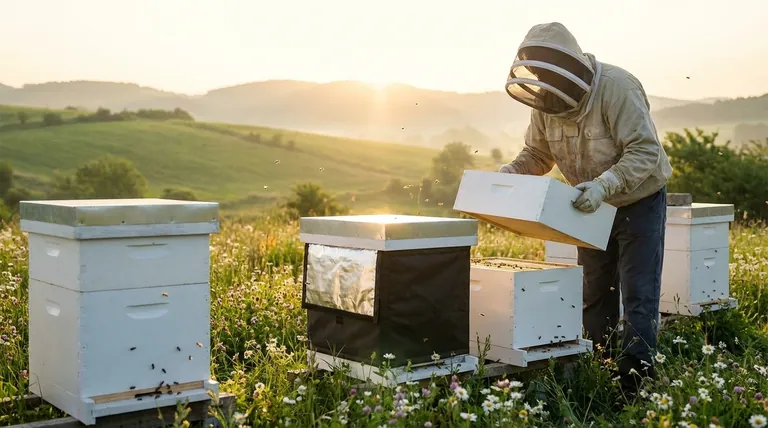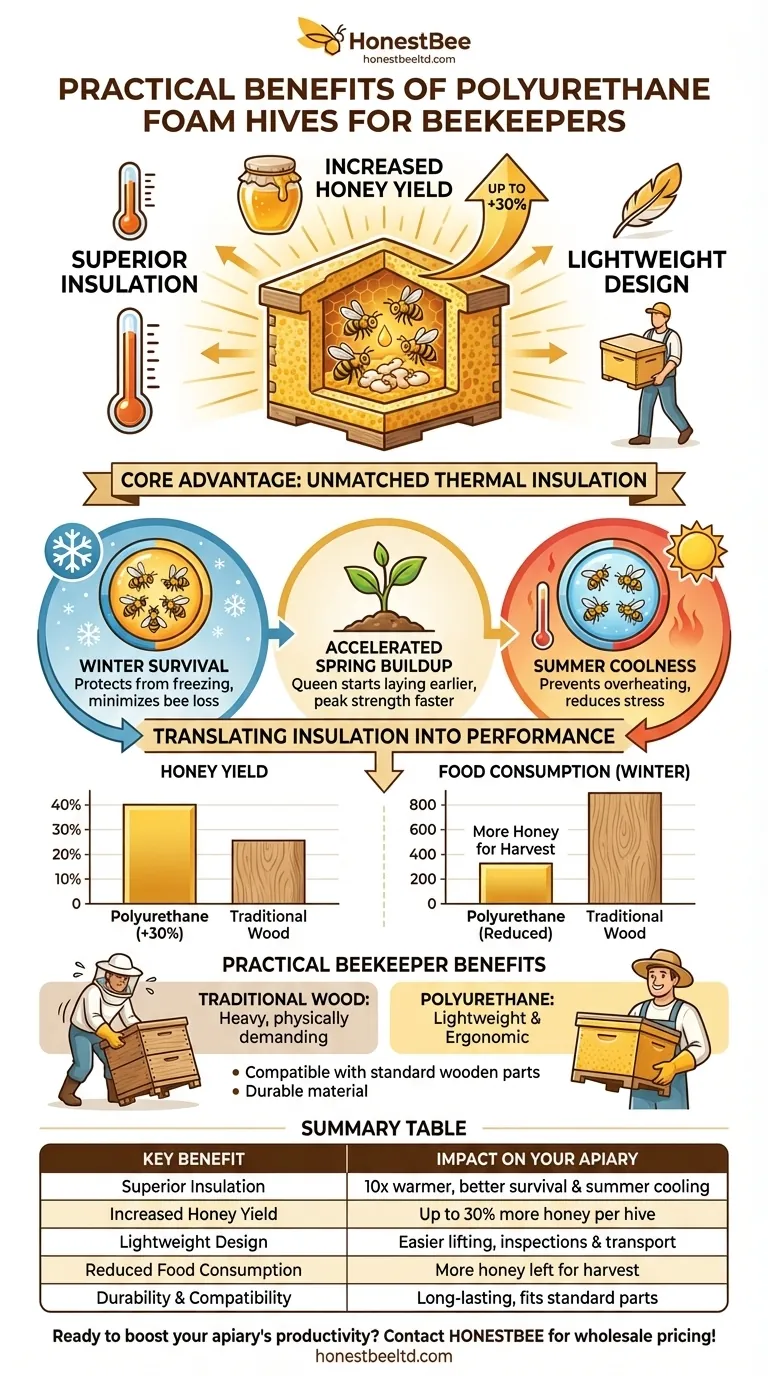The primary benefits of polyurethane foam hives are superior insulation, increased honey production, and a lightweight design. This advanced material is ten times warmer than wood, allowing bees to use far less energy maintaining the hive's temperature. This energy savings directly translates into better winter survival, faster spring development, and a honey yield that can be up to 30% higher than in traditional hives.
The core advantage of polyurethane foam is that it fundamentally changes the energy equation for a bee colony. By minimizing the effort bees spend on temperature regulation, it frees them to focus entirely on brood rearing and honey collection, leading to stronger, more productive hives.

The Core Advantage: Unmatched Thermal Insulation
Polyurethane foam's key feature is its exceptional ability to insulate. This single property creates a cascade of benefits for both the bees and the beekeeper throughout the year.
Superior Winter Survival
In cold climates, bees must vibrate their flight muscles to generate heat, consuming their precious honey stores to survive. The high insulation value of foam hives drastically reduces heat loss, protecting the colony from freezing and minimizing bee loss.
Accelerated Spring Buildup
Because the hive remains warmer and more stable, bee colonies can begin developing earlier in the spring. The queen starts laying sooner, allowing the colony to build its population and reach peak strength faster than those in wooden hives.
Maintaining Summer Coolness
Insulation works both ways. During hot summers, a polyurethane hive maintains a cooler internal temperature, preventing the colony from overheating and reducing the stress on the bees.
Translating Insulation into Performance
The thermal efficiency of polyurethane foam isn't just about survival; it's about optimizing the hive for peak performance and productivity.
A 30% Increase in Honey Yield
The most significant outcome of this energy efficiency is a substantial increase in honey production. With less energy spent on heating and cooling, the bees can dedicate more foraging flights to nectar collection, resulting in yields reportedly 30% higher than in wood or other materials.
Reduced Food Consumption
A well-insulated hive means the colony consumes fewer of its own honey stores, especially during winter. This leaves more honey available for harvest and ensures the bees have ample food to last until the first spring nectar flow.
Practical Benefits for the Beekeeper
Beyond the benefits for the bees, polyurethane hives offer tangible advantages that make the practice of beekeeping easier and more efficient.
Lightweight and Ergonomic
Polyurethane hives are significantly lighter than their wooden counterparts. This makes lifting boxes, performing inspections, and moving entire hives for migratory beekeeping much less physically demanding.
Durability and Compatibility
The material is durable and designed to be functional and long-lasting. Importantly, many polyurethane hive components are manufactured to be compatible with standard wooden hive parts, allowing for easy integration into an existing apiary.
Understanding the Trade-offs: Foam vs. Wood
While the performance benefits are clear, it is important to consider the differences compared to traditional wooden hives to make an informed decision.
Initial Investment
Polyurethane hives can represent a higher upfront cost compared to basic woodenware. This initial investment must be weighed against the long-term gains from higher honey yields and improved colony survival rates.
Long-Term Durability
Wood, with proper maintenance, can last for decades. High-density polyurethane is also very durable, but it can be more susceptible to physical damage from improper handling or prying with a hive tool if you aren't careful.
Beekeeper Preference
Some beekeepers simply prefer the traditional aesthetic and natural, breathable quality of wood. This is a valid consideration, as your enjoyment and comfort with your equipment are key to successful beekeeping.
Making the Right Choice for Your Apiary
The decision to use polyurethane hives should be based on your specific climate, goals, and beekeeping style.
- If your primary focus is maximizing honey production: The potential 30% increase in yield makes polyurethane hives a compelling choice for improving profitability.
- If you live in a region with harsh winters or hot summers: The superior thermal insulation provides a decisive advantage for colony survival and health.
- If you practice migratory beekeeping or have physical limitations: The lightweight nature of these hives will dramatically reduce the strain of managing and transporting your colonies.
Ultimately, choosing polyurethane is an investment in reducing the environmental stress on your bees, enabling them to thrive and perform at their absolute peak.
Summary Table:
| Key Benefit | Impact on Your Apiary |
|---|---|
| Superior Insulation | 10x warmer than wood; better winter survival & summer cooling |
| Increased Honey Yield | Up to 30% more honey production per hive |
| Lightweight Design | Easier lifting, inspections, and migratory beekeeping |
| Reduced Food Consumption | Bees use less honey stores, leaving more for harvest |
| Durability & Compatibility | Long-lasting and compatible with standard wooden hive parts |
Ready to boost your apiary's productivity and resilience?
As a leading wholesale supplier to commercial apiaries and distributors, HONESTBEE provides high-quality, performance-driven beekeeping equipment. Investing in polyurethane foam hives from HONESTBEE is an investment in your bottom line—enabling your bees to thrive with less stress and produce significantly higher honey yields.
Let's discuss how our hive solutions can transform your operation. Contact HONESTBEE today for wholesale pricing and expert advice!
Visual Guide

Related Products
- Professional Insulated Winter Hive Wrap for Beekeeping
- Professional Insulated Plastic Bee Hives
- Wholesales Dadant Size Wooden Bee Hives for Beekeeping
- Honey Flow Garden Bee Hive Flow Hive Best Beehive for Beginners
- HONESTBEE Professional Long Handled Hive Tool with Precision Cutting Blade
People Also Ask
- What are the durability features of Bee Blankets? Built to Last in Demanding Apiary Conditions
- What is the advantage of an insulated outer cover? Boost Winter Survival & Spring Buildup
- Should bee hives be insulated? Protect Your Colony from Moisture, Not Just Cold
- What are the steps to properly wrap a beehive for winter? Ensure Your Colony Survives the Cold
- Why is it important to insulate beehives during winter? Boost Your Colony's Survival Rate



















